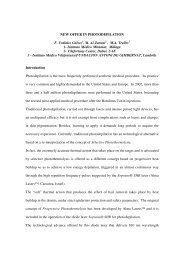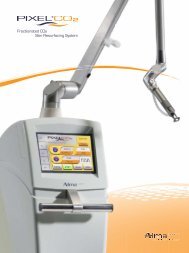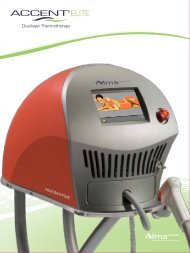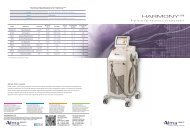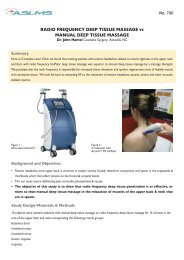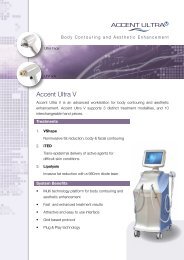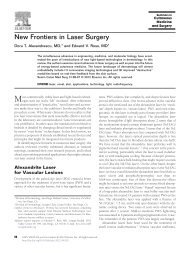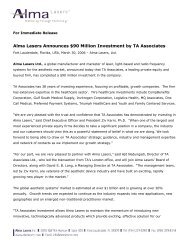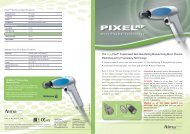Harmony - Hybrid System for Combined Therapies - Alma Lasers
Harmony - Hybrid System for Combined Therapies - Alma Lasers
Harmony - Hybrid System for Combined Therapies - Alma Lasers
- No tags were found...
Create successful ePaper yourself
Turn your PDF publications into a flip-book with our unique Google optimized e-Paper software.
Novel Non-Ablative Approach using ClearLift TM High Power Q-Switched 1064-nmNd:YAG Laser <strong>for</strong> Aged-Skin RepairMacrene Alexiades-Armenakas, MD PhDDermatology and Laser Surgery Center, New York, NYAssistant Clinical Professor, Yale University School of Medicine, New Haven, CT, USABackground Scientific research in the field of energy- and light-based procedures made it possible to develop a very newand innovative generation of lasers which combine the benefit of a non-ablative and a fractionated laser device promising animproved method to revitalize aging skin without harming the epidermis. With this pilot case series we per<strong>for</strong>med one ofthe first systematic reports evaluating efficacy and safety of the non-ablative Q-Switched 1064-nm neodymium:YAG laserdevice in the treatment of rhytids of the face, neck and chest. Methods Seven healthy female subjects (Mean 53.8 ± SD10.0) with visible signs of facial and neck skin aging were treated with non-ablative Q-Switched 1064-nmneodymium:YAG laser device (ClearLift TM , <strong>Alma</strong> ® <strong>Lasers</strong>). Treated areas were the face, including the periorbital andperioral regions (particularly the upper lip), neck and chest. Treatments consisted of 3 sessions at 2-4 week intervals.Follow-up was per<strong>for</strong>med monthly following the final treatment. The Alexiades-Armenakas Comprehensive Grading Scaleof Skin Aging was employed to assess efficacy. Pain ratings were recorded by 10-point visual assessment scoring. ResultsEmploying the validated, quantitative grading scale <strong>for</strong> rhytids of the face and neck, a 0.29 grade improvement or 11.3%improvement over baseline grade was observed in the 7-subject cohort that completed follow-up following a mean ofapproximately 2 treatments at approximately 1 month follow-up. No pain and rapidly resolving minimal erythema werenoted in all subjects during treatment. Conclusion The results of this pilot case series suggest that the treatment with thenon-ablative Q-Switched 1064-nm Nd:YAG laser device significantly improves superficial rhytides. With its outstandingsafety it seems to be particularly suitable <strong>for</strong> the treatment of sensitive areas, such as periorbital, lip, neck and chest. TheQ-switched Nd:YAG laser is a facile, safe and fast treatment <strong>for</strong> improving the appearance of aged skin.INTRODUCTION<strong>Lasers</strong> direct a high-energy beam of a single wavelengthof coherent light into specific tissues, varying in strengthand the type of tissue they target 1-3 Corresponding to itschronological development two main laser classificationshave been established in the past regarding the degree ofablation and recovery 7 . Ablative laser systems, e.g. CO 2and Er:YAG lasers, were among the first resurfacingdevices which were proven successful 2,3 . Althoughhighly effective <strong>for</strong> treating photoaged skin, the demand<strong>for</strong> less ablative treatments became evident because ofthe high risk of unwanted side effects, e.g. scarring,infections, edema or prolonged erythema, combined witha long recovery period and painful treatment sessions.Based upon the concept of selective photothermolysis,presented by Anderson and Parrish in the early 80s, asecond less-invasive treatment modality was developed,promising good results while preserving the epidermis.This non-ablative technique was based on the principle ofabsorption of light and the different chromophores in theskin, such as water, melanin or hemoglobin resulting inselected damage limited to the target 1A novel non-ablative Q-switched Nd:YAG 1064-nmlaser technology is presented here, which combines thebenefit of a non-ablative and a fractionated laser device:a controlled dermal wound is produced by this nearinfraredwavelength, but without harming the epidermis(Figure 1). All stages of wound healing occur under thebiologic protection of an intact epidermis, so that no preorpostoperative care is necessary 4,5 Moreover thetreatment is gentle, com<strong>for</strong>table, and promises todecreases the appearance of fine lines and wrinkles bystimulating collagen growth and skin remodeling 6 . Theaim of this pilot study was to evaluate efficacy and safetyof this new, novel, non-ablative Q-switched 1064-nmneodymium:YAG laser device (ClearLift TM , <strong>Alma</strong> ®<strong>Lasers</strong> ) in the treatment of the many signs of aging skinincluding fine lines, and wrinkles at face and neck.Material and MethodsSubjectsSeven healthy female subjects, between 42 and 70 yearsof age (Mean 53.6 ± SD 10.0), with visible signs of facialand neck skin aging, minimum grade 2.0 on the 4.0grading scale (The Alexiades-Armenakas ComprehensiveGrading Scale of Skin Aging) 7 were enrolled. Verbaland written in<strong>for</strong>med consent was obtained. The subjectswere in good health and none had skin disease or tookmedications that would impact the skin. Women whowere pregnant, planned a pregnancy, and/or nursed achild were excluded from the trial. Also individuals witha history of cosmetic treatments, e.g. botulinum toxin,hyaluronic acid, lasers, as well as surgical “cosmetic”procedures (e.g. face-lift) in the treatment area and© 2012 by <strong>Alma</strong> <strong>Lasers</strong> 1www.almalasers.com
females that have started or changed hormonereplacement therapy within 3 months from study startcould not participate in the trial.Treatment procedureThe ClearLift TM , is a non-ablative, high powerQ-switched 1,064nm Nd:YAG laser handpiece with apassive refractive optical element that creates a 5x5 mmmatrix with 25 microscopic columns of laser-mediatedeffects (microcolumns) measuring ~200µm in diameterper microcolumn and high power density per pixel.(a)(b)Figure 1. Fractionated ablative Pixel Er:YAG (a) vsNon-ablative Pixel QSW (ClearLift). (b). Noticeableepidermis evaporation, coagulation and secondarythermal damage (yellow line) and no rete ridges vsnormal appearance of the epidermis and rete ridges,respectively.The maximal fluence of 1200 mJ and a spot size of 5 mmwere employed. The repetition rate of the laser wasadjusted to 4 Hz. The ClearLift TM module is used withthe <strong>Harmony</strong> XL plat<strong>for</strong>m (<strong>Alma</strong> <strong>Lasers</strong> Ltd., Caesarea,Israel). A series of passes (8-12) were administered toeach treatment area measuring approximately 20 cm 2until the clinical endpoint of diffuse confluent erythemawas attained uni<strong>for</strong>mly throughout and repeated until theentire area (face, neck, or chest) was covered. Treatmentof each anatomic region (eg. face, neck or chest) requiredapproximately 20 minutes per site, totaling 400 joules pertreatment area <strong>for</strong> the face (1600 joules <strong>for</strong> full face and3600 joules total <strong>for</strong> chest. Treated areas included theface, including the periorbital and perioral regions(particularly the upper lip), neck and chest. Treatmentsconsisted of 3 sessions at 2-4 week intervals. Follow-upwas per<strong>for</strong>med monthly following the final treatment.Clinical EvaluationThe Alexiades-Armenakas Comprehensive GradingScale of Skin Aging 7 was employed to assess efficacy.This 4-point grading scale has been extensively testedand employed <strong>for</strong> evaluating laser and energy-basedcosmetic treatments. Digital photographs were taken atbaseline, and at each follow up interval. Grading wasconducted by the investigator at baseline and at eachfollow-up interval in each category following ClearLifttreatment in the current study. For safety evaluations,patients were evaluated after treatment. Pain ratingsusing a 10-point visual assessment scoring (1=no pain,10=worst pain ever felt) were recorded immediately uponconclusion of the treatment. Patients were instructed tomonitor <strong>for</strong> side effects or complications and to followup during the post-treatment interval should any adverseevents arise. At the follow-up intervals, patients filled outpost-treatment questionnaires regarding adverse eventsand clinical outcome.ResultsEfficacySeven female subjects were enrolled in this pilot caseseries and completed all treatment and follow-up visits.Efficacy was scored on rhytids of the face using theAlexiades-Armenakas grading scale. The mean baselinegrade in rhytids across the subject population was 2.54 (±SD 0.45). The mean number of treatments was 2.57 (±SD 0.49) with a mean follow-up interval to date of 1.29(± 0.7) months following final treatment. In the 7-subjectcohort mean follow-up grade was 2.25 (± SD 0.38). Themean grade improvement was 0.29 grades or 11.3%improvement from baseline following an average of 2treatments at the 1-month follow-up interval (Table 1 &Figure 2).SafetySubjects rated pain associated with the treatmentimmediately post-treatment using a10-point visual assessment scale (1=no pain, 10=worstpain ever felt). The VAS pain rating was reported as 1across the 7 trial subjects (Table 1). Immediately after thetreatment, mild confluent erythema was observed in allsubjects. Erythema dissipated within minutes to one hourin all subjects. In two subjects, pinpoint petechiae wereobserved in the infraorbital region when vascular darkcircles were present pre-operatively. These petechiaeresolved within 48 hours. No other adverse events wererecorded. There was no incidence of edema, ecchymosis,crusting, vesiculation or dyspigmentation. No scarringwas observed.DiscussionScientific research in the field of energy- and light-basedprocedures made it possible to develop a very new andinnovative generation of lasers which combine thebenefit of a non-ablative and a fractionated laser devicepromising improvements in the appearance of aging skinwithout harming the epidermis 4-6 . With this pilot caseseries we per<strong>for</strong>med one of the first systematic reportsevaluating efficacy and safety of the non-ablativeQ-Switched 1064-nm neodymium:YAG laser device© 2012 by <strong>Alma</strong> <strong>Lasers</strong> 2www.almalasers.com
(ClearLift TM , <strong>Alma</strong> ® <strong>Lasers</strong>) in the treatment of rhytids ofthe face, neck and chest. Employing the validated,quantitative grading scale <strong>for</strong> rhytids of the face andneck 8 a 0.29 grade improvement or 11.3% improvementover baseline grade was observed in the 7-subject cohortthat completed follow-up following a mean ofapproximately 2 treatments at approximately 1 monthfollow-up. Additional improvement is expected withfurther follow-up intervals, as has been demonstratedwith all prior non-ablative treatments.Subject Age Rx# Follow-Up(months)BaselinePost-TreatmentTable 1. Demographics , VAS Scores and Rhytid Gradesat Baseline and Post-Treatment with Non-Ablative Q-switched Nd:YAG (1064 nm) Laser.The preliminary case series presented here demonstratesthat the treatment with the novel non-ablativeQ-Switched 1064-nm neodymium:YAG laser device(Pixel QS Nd:YAG, <strong>Alma</strong> <strong>Lasers</strong> TM ) appears to beeffective in the treatment of fine lines and wrinkles of theface, neck and chest with the significant advantages ofbeing virtually painless and requiring no recovery time.Clinical outcome was observed beginning at two weeksfollowing the first treatment and results in a less wrinkledand superiorly textured skin, especially around the eyesand perioral. Although the exact mechanism of action isnot fully elucidated 9 , it is generally accepted that the noninvasiveinduction of the dermal wound healing reactionmay be the reason <strong>for</strong> the rapid responder rate 10 . Thistechnology is based on the heating of the sub-dermallayer and the underlying extracellular matrix, which isfollowed by tissue contraction. This controlled thermalinjury results in tissue shrinkage followed by aninflammatory response accompanied by the migration offibroblasts into the area 11,12 . This proliferative phase isthere<strong>for</strong>e characterized by an up-regulation of collagenexpression (neocollagenesis/remodeling) 9 , therebyresulting in contracture and tightening of the injuredVAS1 70 3 1 3.5 3 12 43 3 1 2.25 2 13 57 3 3 2.5 2.25 14 55 2 1 2.25 2 15 60 2 1 2.5 2.25 16 42 3 1 2 1.75 17 48 2 2 2.75 2.5 1Mean 53.57 2.57 1.29 2.54 2.25 1SD 10.01 0.49 0.70 0.45 0.38 0tissues. This newly deposited extracellular matrix may beused to strengthen the skin 13 .In years past, the Q-switched Nd:YAG (1064 nm) wasemployed <strong>for</strong> non-ablative laser resurfacing 14-16 , howeverthe current device presents several importanttechnological advances that likely account <strong>for</strong> the resultsdocumented during this study. In the 1990’s theQ-switched Nd:YAG (1064 nm) was employed in defocusedmode at 6-15 J/cm 2 and a 6 mm spot size <strong>for</strong> thetreatment of rhytides, with mild efficacy. These reportssuggested improvement in fine wrinkles and skinelasticity 4,15,17 . The focal point of the standard Q-switched Nd:YAG (1064 nm) had been designed at theskin surface, to target melanin pigment, therebynecessitating its application in defocused mode to avoidcrusting and splatter. In contrast, the Q-switchedNd:YAG (1064 nm) described here has a focal point of100 μm, just beneath the epidermis, with greaterpenetration in the absence of epidermal crusting. Afocused delivery option of this wavelength also results ina far higher peak power of up to 130 J/cm 2 per pixel,which likely explains the achieved results with thistechnology. Since the wavelength is applied directly tothe skin surface instead of in defocused mode,penetration depth of up to 3.5-4 mm is expected, whichmay also play a role in the reported outcomes here ascompared to prior modalities 18 .In marked contrast to other laser devices 19-21 results showalso that the treatment with the current ClearLift, Q-switched Nd:YAG (1064 nm) laser is characterized by anobserved safety, even <strong>for</strong> areas with high risk of scarringsuch as the chest. Minimal discom<strong>for</strong>t and rapidlyresolving minimal erythema were noted in all subjectsduring treatment. No recovery time was required. Noadverse events were reported.ConclusionThe results of this clinical study suggest that thetreatment with the non-ablative Q-Switched 1064-nmneodymium:YAG laser device (ClearLift, <strong>Alma</strong> <strong>Lasers</strong>)significantly improves superficial rhytides. With itsobserved safety it seems to be particularly suitable <strong>for</strong> thetreatment of sensitive areas, such as periorbital, lip, neckand chest. The ClearLift Q-switched Nd:YAG laser is afacile, reliable and fast approach <strong>for</strong> treating skinimperfections which is both virtually painless andwithout down-time.© 2012 by <strong>Alma</strong> <strong>Lasers</strong> 3www.almalasers.com
(a)(b)9. Dang Y, Ye X, Weng Y et al. Effects of the 532-nm and 1,064-nm Q-switched Nd:YAG laserson collagen turnover of cultured human skinfibroblasts: a comparative study. <strong>Lasers</strong> MedSci. 2010; 25: 719–726.(c)(d)Figure 2. Be<strong>for</strong>e (a/c) and after (b/d) after 1 month, 2treatments with ClearLift TM (Pixel QS Nd:YAGlaser).Literature1. Alexiades-Armenakas MR, Dover JS, ArndtKA. The spectrum of laser skin resurfacing:nonablative, fractionated, and ablative laserresurfacing. J Am Acad Dermatol. 2008; 58:719–737.2. Cohen SR, Henssler C, Johnston J. Fractionatedphotothermolysis <strong>for</strong> skin rejuvenation. PlastReconstr Surg. 2009; 124: 281–290.3. Rinaldi F. Laser: A review. Clin Dermatol.2008; 26: 590–601.4. Menaker GM, Wrone DA, Williams RM et al.Treatment of facial rhytids with a nonablativelaser: a clinical and histologic study. DermatolSurg. 1999; 25: 440–444.5. Bedi VP, Chan KF, Sink RK et al. The effects ofpulse energy variations on the dimensions ofmicroscopic thermal treatment zones innonablative fractionated resurfacing. <strong>Lasers</strong>Surg Med. 2007; 39: 145–155.6. Orringer JS, Rittié L, Baker D et al. Molecularmechanisms of nonablative fractionated laserresurfacing. Br J Dermatol. 2010; 163: 757–768.7. Alexiades-Armenakas M. Rhytides, laxity, andphotoaging treated with a combination ofradiofrequency, diode laser, and pulsed light andassessed with a comprehensive grading scale. JDrugs Dermatol. 2006; 5: 731–738.8. Alexiades-Armenakas M. A quantitative andcomprehensive grading scale <strong>for</strong> rhytides, laxity,and photoaging. J Drugs Dermatol. 2006; 5:808–809.10. Goldberg DJ, Silapunt S. Histologic evaluationof a Q-switched Nd:YAG laser in thenonablative treatment of wrinkles. DermatolSurg. 2001; 27: 744–746.11. Weng Y, Dang Y, Ye X et al. Investigation ofirradiation by different nonablative lasers onprimary cultured skin fibroblasts. Clinical andExperimental Dermatology. 2011; 36: 655–660.12. Shukla A, Dubey MP, Srivastava R et al.Differential expression of proteins duringhealing of cutaneous wounds in experimentalnormal and chronic models. Biochem BiophysRes Commun. 1998; 244: 434–439.13. Sadick NS. Update on non-ablative light therapy<strong>for</strong> rejuvenation: a review. <strong>Lasers</strong> Surg Med.2003; 32: 120–128.14. Lee MC, Hu S, Chen MC et al. Skinrejuvenation with 1,064-nm Q-switchedNd:YAG laser in Asian patients. Dermatol Surg.2009; 35: 929–932.15. Goldberg DJ, Whitworth J. Laser skinresurfacing with the Q-switched Nd:YAG laser.Dermatol Surg. 1997; 23: 903–906.16. Yaghmai D, Garden JM, Bakus AD et al.Photodamage therapy using an electro-optic Q-switched Nd:YAG laser. <strong>Lasers</strong> Surg Med.2010; 42: 699–705.17. Goldberg D, Metzler C. Skin resurfacingutilizing a low-fluence Nd:YAG laser. J CutanLaser Ther. 1999; 1: 23–27.18. Bashkatov AN, Genina EA, Kochubey VI,Tuchin VV. Optical properties of human skin,subcutaneous and mucous tissues in thewavelength range from 400 to 2000 nm. J PhysD: Appl Phys. 2005; 38: 2543–2555.19. Fitzpatrick RE, Goldman MP, Sriprachya-AnuntS. Resurfacing of photodamaged skin on theneck with an UltraPulse((R)) carbon dioxidelaser. <strong>Lasers</strong> Surg Med. 2001; 28: 145–149.20. Tanzi EL, Williams CM, Alster TS. Treatmentof facial rhytides with a nonablative 1,450-nmdiode laser: A controlled clinical and histologicstudy. Dermatol Surg. 2003; 29: 124–128.21. Majaron B, Kelly KM, Park HB et al. Er:YAGlaser skin resurfacing using repetitive long-pulseexposure and cryogen spray cooling: I.Histological study. <strong>Lasers</strong> Surg Med. 2001; 28:121–130.© 2012 by <strong>Alma</strong> <strong>Lasers</strong> 4www.almalasers.com



